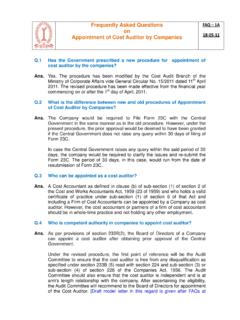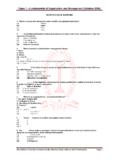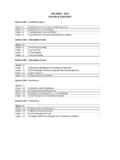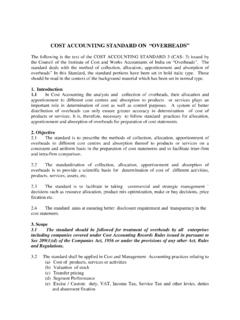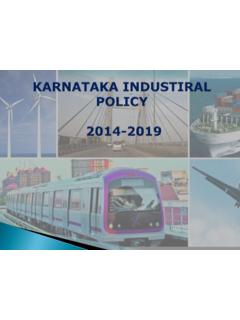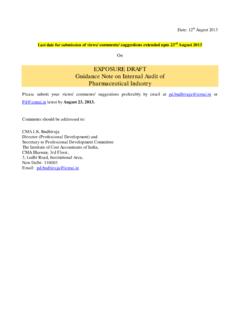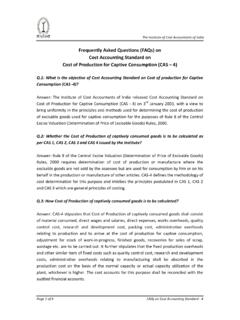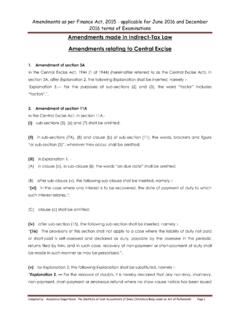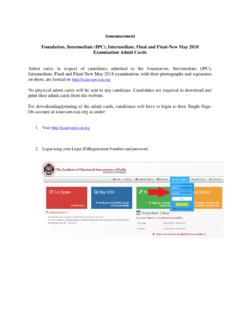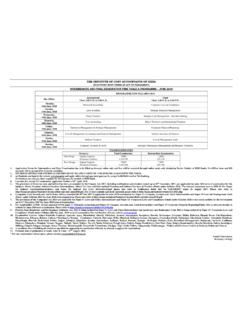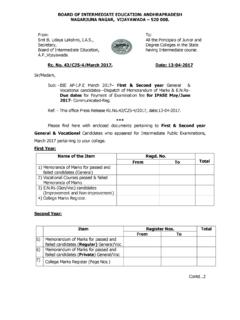Transcription of INTERMEDIATE EXAMINATION GROUP II …
1 Suggested Answers to Question CMA INSTITUTE OF COST ACCOUNTANTS OF INDIA (Statutory Body under an Act of Parliament) Page 1 INTERMEDIATE EXAMINATION GROUP II (SYLLABUS 2008) SUGGESTED ANSWERS TO QUESTIONS JUNE 2013 PAPER- 8 : COST AND MANAGEMENT ACCOUNTING Time Allowed : 3 Hours Full Marks : 100 The figures in the margin on the right side indicate full marks. Question is compulsory. Answer any five from the rest. 1. (a) Match the statement in Column I with the appropriate statement in Column II: 1x5=5 Column I Column II (i) Apportionment of Overheads (ii) Equivalent Production (iii) Point Ranking Method (iv) Output Costing (v) Non Integrated Accounts (A) Job Evaluation (B) Reciprocal Method (C) Cost Ledger Accounts (D) Process Costing (E) Coal Industry (b) State whether the following statements are 'True' or 'False': 1x5=5 (i) Fixed cost per unit remains constant irrespective of the number of units of output.
2 (ii) An efficient worker always gets more bonus under Rowan Plan than under 50% Halsey Plan. (iii) A bin card shows the quantity and value of a stores item. (iv) Cost Ledger Control Account is maintained in the costing books while General Ledger Adjustment Account is maintained in the financial books. (v) In LIFO method of valuing inventory, the company has to suffer loss due to accumulation of old stocks and consequent spoilage and obsolescence. (c) Fill in the blanks suitably: 1x5=5 (i) _____centre is defined as a business entity's segment by which both revenues are earned and costs are incurred. (ii) _____ Level of stores inventory is maximum usage multiplied by maximum lead time. (iii) The most appropriate cost unit for pricing and costing goods transport is _____. (iv) Where the production is as per the requirements of the customers, _____is the method of costing used.
3 (v) Where there are two raw materials A and B, and the total material mix variance is favourable and if A has a favourable mix variance, then B will have a mix variance that is _____. (d) In the following cases, one of the four given answers is correct. You are required to indicate the correct answer (=1 mark) and give brief workings (=1 mark): 2x5=10 (i) T Ltd. uses pre-determined overhead rate of ` 15 per labour hour. The actual Suggested Answers to Question CMA INSTITUTE OF COST ACCOUNTANTS OF INDIA (Statutory Body under an Act of Parliament) Page 2 labour hours are 5750 and the actual overhead cost is ` 85,000. There is (a) ` 1,250 over absorption (c) ` 1,000 over absorption (b) ` 1,250 under absorption (d) ` 1,000 under absorption (ii) A chemical process has a normal yield of 90%. In a period, 5000 kgs of material were introduced and there was an abnormal loss of 150 kgs.
4 The quantity of good production is (a) 4850 kgs (c) 4500 kgs (b) 4650 kgs (d) 4350 kgs (iii) If break-even sales is 60% of current sales and profit is ` 60,000, then the amount of contribution will be (a) ` 1,00,000 (c) ` 1,50,000 (b) ` 36,000 (d) ` 1,86,000 (iv) The following information is given for the next year: Budgeted Sales = 5,00,000 units Finished Goods: Closing Stock = 1,50,000 units; Opening Stock = 80,000 units. Equivalent units of WIP: Closing Stock= 60,000 units; Opening Stock = 50,000units. The number of equivalent units produced would be (a) 5,80,000 units (c) 5,00,000 units (b) 5,50,000 units (d) 5,75,000 units (v) A production process has the capacity to produce either 4,000 units of A or 3,500 units of B or 5,000 units of C. Only one product can be made in a production period. The contributions per unit of A, B and C are Rs. 10, Rs. 11 and Rs. 8 respectively. The opportunity cost of A would be (a) ` 44,000 (c) ` 50,000 (b) ` 38,500 (d) ` 40,000 Answer1.
5 (a) Column I Column II i) (B) ii) (D) iii) (A) iv) (E) v) (C) (b) i) False Fixed costs per unit varies with the change in the volume of production , fixed cost per unit decreases as the production increases and vice versa. Example: Say Fixed Cost Rs. 1,00,000, units produced = 10,000 Fixed Cost / Units Produced = Now, If production is increased to 12,000 Fixed Cost / Units Produced = 000,12000,00,1= If Production is decreased = 8,000 Fixed Cost / Units Produced = 000,8000,00,1= ii) False If we have time taken = 140, time allowed = 200, time saved = 60 & Rate = Re. 1 Bonus in, Suggested Answers to Question CMA INSTITUTE OF COST ACCOUNTANTS OF INDIA (Statutory Body under an Act of Parliament) Page 3 Halsey Plan = 50% x 60 x 1 = ` 30 Rowan Plan = (60/200) x 140 x 1 = ` 42 Here, Bonus is more in case of Rowan Plan Again, if we have time taken = 80, time allowed = 200, time saved = 120, which is more than 50% of time allowed.
6 Bonus in, Halsey Plan = 50% x 120 = 60 x Re 1 = ` 60 Rowan Plan = 80/200 x 120 = 48x Re 1 = ` 48 So, Here, Bonus is more in case of Halsey Plan than Rowan Plan. Hence, an efficient worker always does not gets more bonus under Rowan Plan than under 50% Halsey Plan. iii) False A bin card is a quantitative record of receipts issues and closing balances of each item of stores. iv) False General ledger Adjustment Account is also known as cost ledger control account. All transaction of income and expenditure, which originate in financial accounts, are entered in this account for eventual transfer to some control account. In Financial A/c under Self-balancing Ledger we also maintain General Ledger Adjustment A/c. v) False LIFO is the method that is applied to value the inventory, it does not segregate the physical stock with reference to their time of procurement , the old stock and the new stock. So the given statement is not true.
7 (c) i) Profit ii) Reorder iii) Tonne-Kilometer iv) Job Costing v) Adverse Note: For (iii), any measure that represents weight x distance may be considered right, pound-mile/ton-km, ton-mile, etc. (d) Sl. No. Answer Workings: i) (a) Absorbed OH = 15 x 5750 = 86250 Actual OH = 85000 Over Absorption = `1250 ii) (d) Normal Loss = 10% of input = 500 kgs. Abnormal Loss = 150 kgs. Total Loss = 650 kgs. Good Production = 5000 650 = 4350 kgs. iii) (c) BEP = 60% Hence, Margin of Safety = 100 60 = 40% Profit = 60,000 = Contribution on MOS. Hence, Total Contribution = 60,000 40% = ` 1,50,000 iv) (a) Sales + Cl. Stk Op. Stk = Production FG: 500000 + 150000 80000 = 5,70,000 Units WIP: + 60,000 50,000 = 10,000 Units Number of equivalent units produced = 5,80,000 Units v) (d) Opportunity Cost = Cost of next best alternative.
8 Contribution B: 3500 x 11 = ` 38,500 Contribution C: 5000 x 8 = ` 40,000 Opportunity Cost: ` 40,000 Suggested Answers to Question CMA INSTITUTE OF COST ACCOUNTANTS OF INDIA (Statutory Body under an Act of Parliament) Page 4 2. (a) The following are figures relating to a factory for two successive years: Particulars Year I (`) Year II (`) Sales Marginal Cost of Sales 10,00,000 6,00,000 16,80,000 8,00,000 Contribution 4,00,000 8,80,000 During Year II, the selling price increased by 20% and the company implemented a cost reduction programme very aggressively. You are required to analyse the increase in contribution due to (i) Increase in selling price (ii) Increase in sales volume (iii) Reduction in cost 3+4+3=10 (b) How would you deal with the following in Cost Accounts? (i) Fringe Benefits; (ii) Bad Debts. 3+2=5 Answer 2.
9 (a) Year I ` Year II SP increased by 20% ` Year II Actual ` Workings Year II Before SP Increase Sales Loss: Marginal Cost of Sales 10,00,000 6,00,000 12,00,000 6,00,000 16,80,000 8,00,000 Increase in Sales = ` 4,80,000 (16,80,000 12,00,000) Increase in Volume = 12,00,0004,80,000``x 100 = 40% 14,00,000 (10,00,000+40%) 8,40,000 (at year I cost) (6,00,000 + 40%) Contribution 4,00,000 6,00,000 8,80,000 5,60,000 (i) Increase in contribution due to increase in Selling Price=16,80,000 14,00,000=2,80,000 Increase in Volume = 40% If only volume increased, Sales value should have been = 14,00,000 Variable cost should have been = 8,40,000 Contribution should have been = 5,60,000 (ii) Increase in Contribution due to volume increase = 5,60,000 4,00,000 = ` 1,60,000 Variable cost for the increased volume should have been = 8,40,000 It is actually = 8,00,000 (iii) Increase in Contribution due to Cost Reduction = ` 40,000 Reconciliation ` Contribution in Yr.
10 1 Increase due to selling price increase Increase due to increase in volume Increase due to cost reduction 4,00,000 2,80,000 1,60,000 40,000 Contribution in Yr. II 8,80,000 Suggested Answers to Question CMA INSTITUTE OF COST ACCOUNTANTS OF INDIA (Statutory Body under an Act of Parliament) Page 5 (b) (i) Fringe Benefits: These benefits are given in the form of overtime, extra-shift duty allowance, holiday pay, pension facilities etc. there are some non-cash fringe benefits also like canteen facility etc. Expenditure incurred on fringe benefits in respect of factory workers should be treated as factory overheads and apportioned among all the production and service departments on the basis of number of workers in each department. Fringe benefits of office and selling & distributing staff should be treated as administration overheads and selling and distribution overheads respectively and recovered accordingly.
